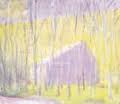Painting Is Not About The Freaking Product
“Ah, to live another 99 years, I’m just beginning to get the idea.” Titian on his deathbed
“I think I’m at last beginning to understand something about it.” Renoir on his deathbed
“All I can say is that painting is terribly difficult. Monet at 83
That Titian and Renoir made such statements on their deathbeds seems a bit apocryphal, but the point is well taken just the same. My interpretation of their remarks is that painting is not what it first might seems, that it is an activity that goes well beyond the simple making of a product. After all, at 83 and perhaps one of the all-time masters of the craft of painting, Claude Monet tells us how difficult painting is. In fact, at this time in his life, he seems to have been destroying as many canvases as he left alone. And as with Titian and Renoir, I don’t think Monet’s frustration stems from problems of “how-to.”
Here’s my point: the activity of painting, if it is to be the rich and fulfilling thing that makes one want to do it everyday, must be something that is truly life-giving. A “high,” so to speak; an unusual, uplifting-type pleasure. Something that as it pleases also empowers. Bottom line: it is not about the freaking product, the painting, the thing, the result!
I find this particular thought – namely, that painting is not about making a product, although products result – to be the hardest thought to communicate to students. My fear – and perhaps insight – is that because we live in a society organized around ever greater horizons of production (we are a “civilization of productivity” as scholars are wont to say), we have become, in the inimitable words of David Viscott, “production freaks.” Even such thoughts as productivity – a painting in the morning, a painting in the afternoon – or the notion of using standard frames or making paintings that fit into suitcases undermines our freedom as expressive creatures. Too pure you say? I don’t think so. There are a zillion little things in our everyday life to which people regularly take offense (a scuff mark on a white sneaker, not screwing on the cap of a bottle of tonic water tightly, driving around in a car that has a dent, some guy who makes love with his socks on – OMG!!). But when it comes to the scared ground of artistic expression, the constraints of production imperatives, otherwise known as the assembly line, are just fine. A bit odd, don’t you think?
I once took a workshop with Wolf Kahn. He’s a great artist in my opinion, not only because of the results he gets, but because of his point of view about the process that begets the results. Although not an Impressionist (in terms of aesthetic), he very much exudes the Impressionist spirit of independence and self-realization through painting. As you ponder what Titian and Renoir were getting at, consider the essence of the point being made here by Kahn:
A picture can be regarded as just another object, another piece of junk (and, regrettably, often an expensive piece of junk, requiring special care). The artist, seen under this light, is a manufacturer of luxury items….The practice of art should have an effect not only on the public, but even more importantly, on the artist himself, by enlarging his sphere of freedom. Once this is understood…the problem of being a mere manufacturer of expensive objects disappears; pictures are justifiable because they are steps in their maker’s artistic development. Each picture is valuable only insofar as it contributes to this development, because it enables the artist to go on in a freer, larger way to his next picture (emphasis added).


What a great insight: the value of a painting turns on the degree to which it contributes to the painter’s development, on the degree to which a painter becomes freer and larger in the process. If we wish to make art as opposed to pictures, it behooves us – Kahn seems to be saying – to spend some time thinking about the value of the payoff in the moment of creation.
Think about it. But don’t wait until you are on your deathbed to get the idea.
3 Comments
Address
Via Teresio Olivelli, 20
22021 Bellagio (CO)
Italy
+39 338 975 7135
Open Hours
Tuesday - Saturday: 11:00am – 6:00pm
Sunday - Monday: 1:00pm – 6:00pm

“I don’t think Monet’s frustration stems from problems of ‘how-to.'”
Wow, great point. I’ve only been painting for about a year and a half and I’m already finding myself gravitating towards more loose painting and a much less literal interpretation of scenes. Then I look at Monet and (eye-sight problems noted) I notice that his paintings seem to border on more abstract, heavy broken color realizations (think Vetheuil in the Fog and Waterlilies). I personally like this expression because I feel much less burdened to create something literal and adore the feeling of painting my sensation — loose and interpretive as it may be… It’s simply much more enjoyable and I feel that power of which you always refer.
Of course my family will NEVER get it…
Thanks for reminding me that I’ve only got a little bit of time to paint what I please.
Sounds like you are getting it quite nicely. One of the reasons I harp on painting not being production, etc is that while painting is very difficult, the difficulty, primarily, lies in shifting gears mentally. Once we start to get the joy of painting – by simply experiencing it – all the rest can be discarded. It is like skipping school. Having said that, I do – unlike so many, such as Wolf Kahn, believe that learning a “proper” method is useful in that it helps us to learn a visual language but we must always keep in mind (and this might satisfy the Kahn types) that a structured method is useful essentially as a booster rocket…something that helps us see and feel, and feel and see. If I had to pick one over the other, I would side with Kahn and say: “just get to the excitement.” In any case, if one gets lost painting his or her heart out, there is nothing that, I suspect, competes with that high. And what is wonderful about it, it is then, and maybe only then, that the damn painting seems to get a life too.
As a former teacher educator and now in my reincarnation as a teacher of drawing and painting with a group of wonderful developing artists, it has always been my practice to stress process over product….even in a school system and a society where product has become increasingly more valued. One of my adolescent academic students once summed it up so eloquently by reflecting: It wasn’t WHAT I learned, it was that I learned HOW to learn. She was attempting to answer my question of whether her parents had made the correct choice by placing her with me for the three years she spent with me in an alternative program. Content had not been our focus but process had been and she so wisely saw the benefits and the result. She went on to graduate from veterinary college “best in her class” to prove the point. More importantly she has gone on to be a wonderful mother and wife as well as a successful doctor and is considering returning to university as a teacher. I know she will focus with her students on the importance of the process of healing. Even my beginning artist students are continually frustrated by their “products” not being successful and it is my responsibility as their teacher to help them reflect on what learning took place during the process of producing that apparently “unsuccessful” product and consider what that means to their development as an artist and how they can apply these reflections to their next effort. They struggle with the concept of seeing their work as a developmental process and require guidance to make thoughtful reflections on their and their peers’ works. I feel this phase of the creative process is almost more important than the “doing” part….the time when you force yourself to ask “So I did this piece….so what?” I am sure that Monet was doing just that when he decided to destroy a canvas….so he could learn from the process of doing it and act upon that learning to continue the process through the work on his next canvas. What a humbling example for us all to take as we struggle through our own
processes.